Comprehensive Risk Management Report: Clothing Industry Analysis
VerifiedAdded on 2023/01/11
|5
|1216
|44
Report
AI Summary
This report provides a comprehensive analysis of risk management strategies within the clothing industry. It identifies key risks across the supply chain, including communication breakdowns with suppliers, potential disruptions in raw material sourcing, and the impact of government policies on production costs. The report also addresses manufacturing process risks, such as worker strikes and machine breakdowns, proposing solutions like improved working conditions, employee incentives, regular machine inspections, and quality control. Furthermore, it examines distribution risks, suggesting alternative transportation modes and proactive dispatching strategies to mitigate delays caused by natural calamities. Finally, the report analyzes demand-related risks, emphasizing the importance of monitoring fashion trends and incorporating customer feedback to adapt production and maintain customer satisfaction. The report is supported by multiple references and is structured to provide actionable insights for businesses operating in the clothing industry.
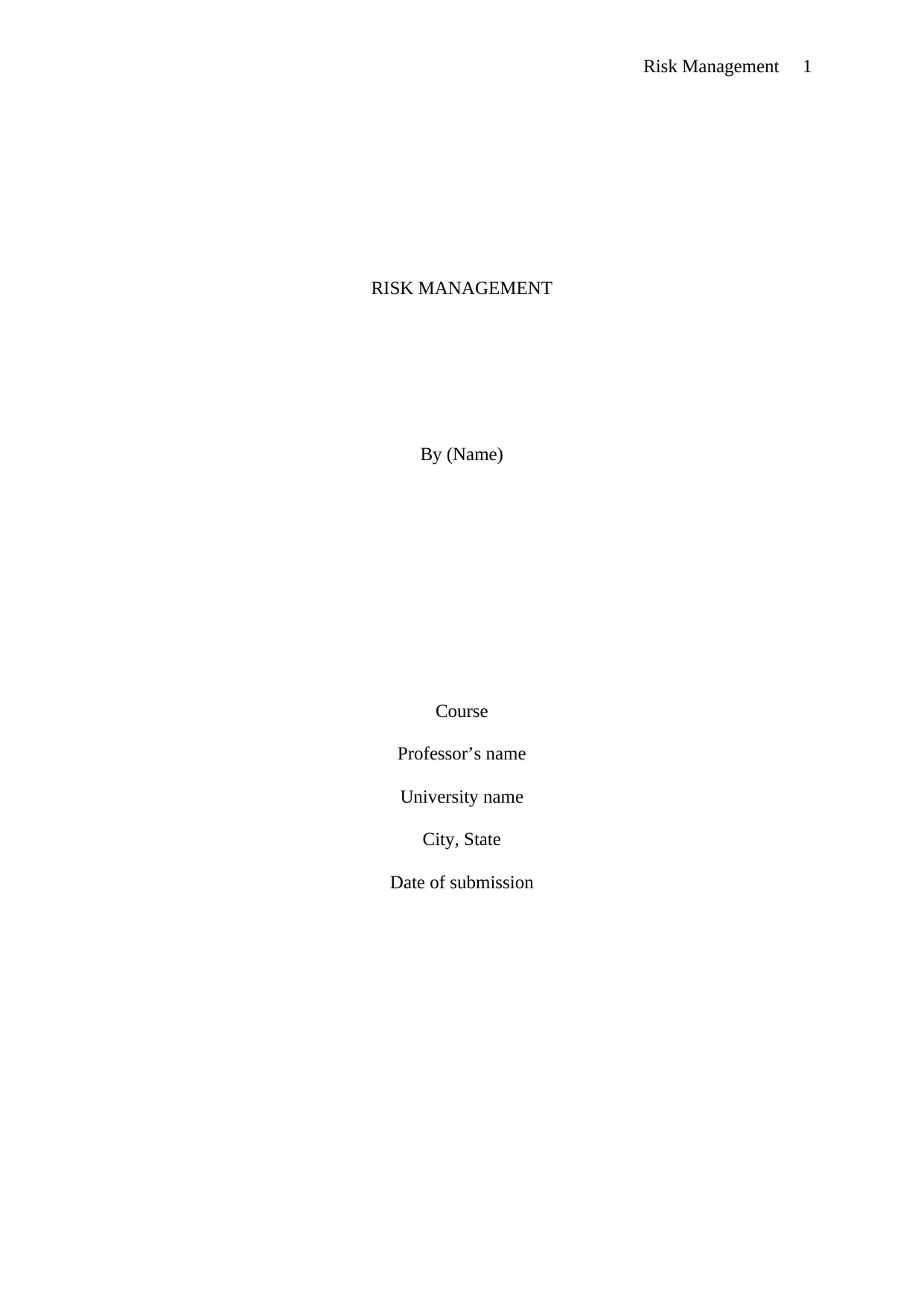
Risk Management 1
RISK MANAGEMENT
By (Name)
Course
Professor’s name
University name
City, State
Date of submission
RISK MANAGEMENT
By (Name)
Course
Professor’s name
University name
City, State
Date of submission
Paraphrase This Document
Need a fresh take? Get an instant paraphrase of this document with our AI Paraphraser
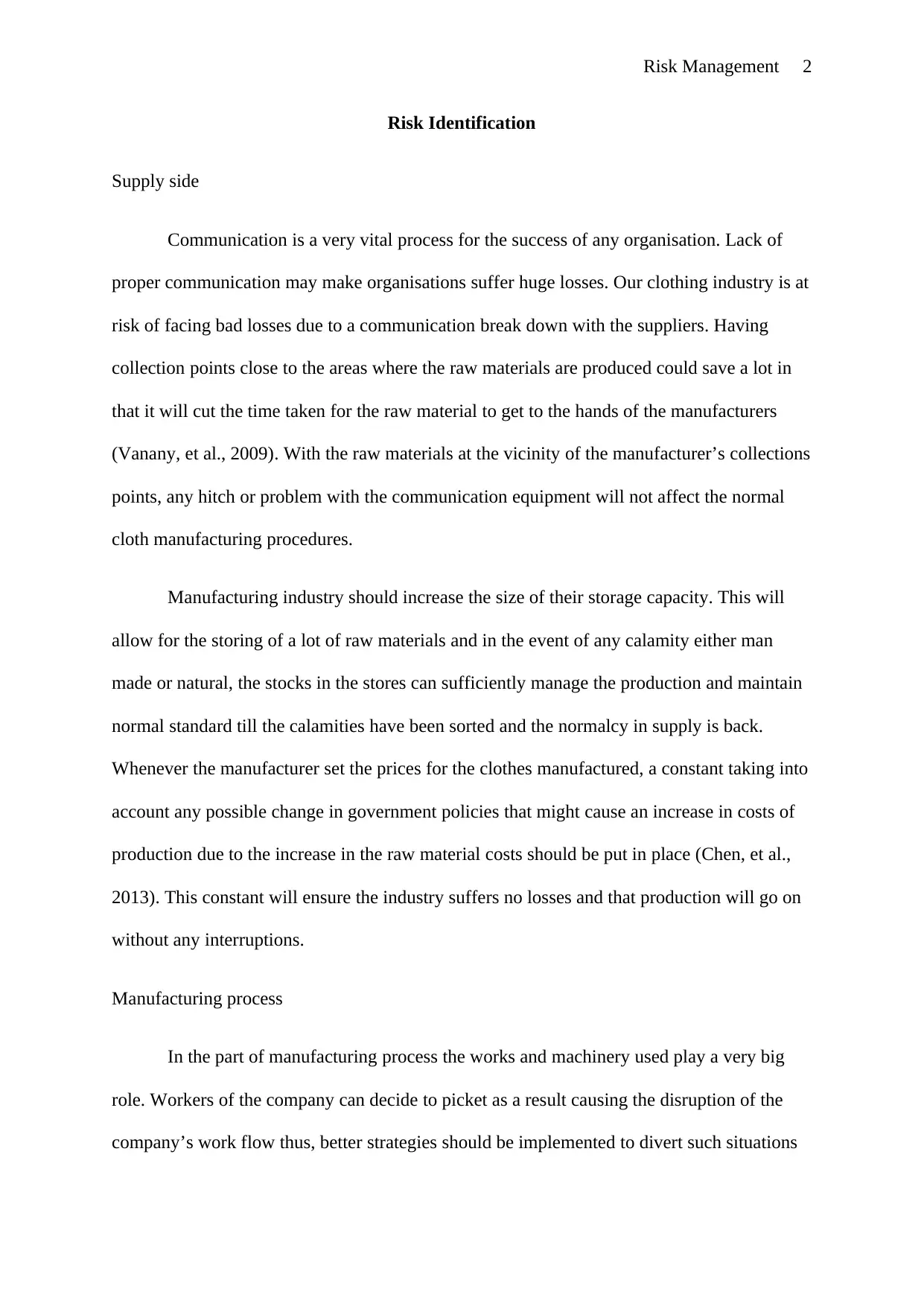
Risk Management 2
Risk Identification
Supply side
Communication is a very vital process for the success of any organisation. Lack of
proper communication may make organisations suffer huge losses. Our clothing industry is at
risk of facing bad losses due to a communication break down with the suppliers. Having
collection points close to the areas where the raw materials are produced could save a lot in
that it will cut the time taken for the raw material to get to the hands of the manufacturers
(Vanany, et al., 2009). With the raw materials at the vicinity of the manufacturer’s collections
points, any hitch or problem with the communication equipment will not affect the normal
cloth manufacturing procedures.
Manufacturing industry should increase the size of their storage capacity. This will
allow for the storing of a lot of raw materials and in the event of any calamity either man
made or natural, the stocks in the stores can sufficiently manage the production and maintain
normal standard till the calamities have been sorted and the normalcy in supply is back.
Whenever the manufacturer set the prices for the clothes manufactured, a constant taking into
account any possible change in government policies that might cause an increase in costs of
production due to the increase in the raw material costs should be put in place (Chen, et al.,
2013). This constant will ensure the industry suffers no losses and that production will go on
without any interruptions.
Manufacturing process
In the part of manufacturing process the works and machinery used play a very big
role. Workers of the company can decide to picket as a result causing the disruption of the
company’s work flow thus, better strategies should be implemented to divert such situations
Risk Identification
Supply side
Communication is a very vital process for the success of any organisation. Lack of
proper communication may make organisations suffer huge losses. Our clothing industry is at
risk of facing bad losses due to a communication break down with the suppliers. Having
collection points close to the areas where the raw materials are produced could save a lot in
that it will cut the time taken for the raw material to get to the hands of the manufacturers
(Vanany, et al., 2009). With the raw materials at the vicinity of the manufacturer’s collections
points, any hitch or problem with the communication equipment will not affect the normal
cloth manufacturing procedures.
Manufacturing industry should increase the size of their storage capacity. This will
allow for the storing of a lot of raw materials and in the event of any calamity either man
made or natural, the stocks in the stores can sufficiently manage the production and maintain
normal standard till the calamities have been sorted and the normalcy in supply is back.
Whenever the manufacturer set the prices for the clothes manufactured, a constant taking into
account any possible change in government policies that might cause an increase in costs of
production due to the increase in the raw material costs should be put in place (Chen, et al.,
2013). This constant will ensure the industry suffers no losses and that production will go on
without any interruptions.
Manufacturing process
In the part of manufacturing process the works and machinery used play a very big
role. Workers of the company can decide to picket as a result causing the disruption of the
company’s work flow thus, better strategies should be implemented to divert such situations
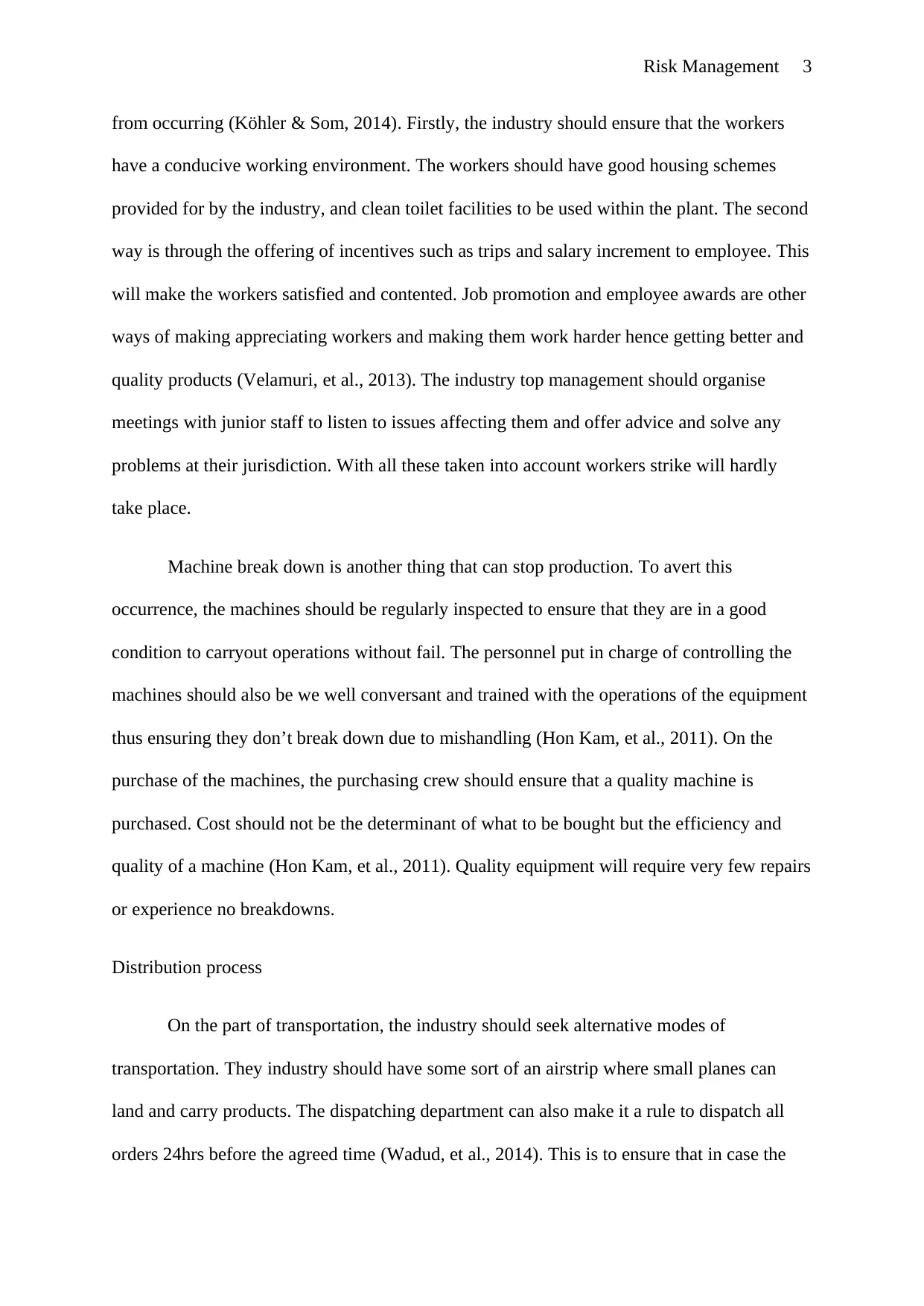
Risk Management 3
from occurring (Köhler & Som, 2014). Firstly, the industry should ensure that the workers
have a conducive working environment. The workers should have good housing schemes
provided for by the industry, and clean toilet facilities to be used within the plant. The second
way is through the offering of incentives such as trips and salary increment to employee. This
will make the workers satisfied and contented. Job promotion and employee awards are other
ways of making appreciating workers and making them work harder hence getting better and
quality products (Velamuri, et al., 2013). The industry top management should organise
meetings with junior staff to listen to issues affecting them and offer advice and solve any
problems at their jurisdiction. With all these taken into account workers strike will hardly
take place.
Machine break down is another thing that can stop production. To avert this
occurrence, the machines should be regularly inspected to ensure that they are in a good
condition to carryout operations without fail. The personnel put in charge of controlling the
machines should also be we well conversant and trained with the operations of the equipment
thus ensuring they don’t break down due to mishandling (Hon Kam, et al., 2011). On the
purchase of the machines, the purchasing crew should ensure that a quality machine is
purchased. Cost should not be the determinant of what to be bought but the efficiency and
quality of a machine (Hon Kam, et al., 2011). Quality equipment will require very few repairs
or experience no breakdowns.
Distribution process
On the part of transportation, the industry should seek alternative modes of
transportation. They industry should have some sort of an airstrip where small planes can
land and carry products. The dispatching department can also make it a rule to dispatch all
orders 24hrs before the agreed time (Wadud, et al., 2014). This is to ensure that in case the
from occurring (Köhler & Som, 2014). Firstly, the industry should ensure that the workers
have a conducive working environment. The workers should have good housing schemes
provided for by the industry, and clean toilet facilities to be used within the plant. The second
way is through the offering of incentives such as trips and salary increment to employee. This
will make the workers satisfied and contented. Job promotion and employee awards are other
ways of making appreciating workers and making them work harder hence getting better and
quality products (Velamuri, et al., 2013). The industry top management should organise
meetings with junior staff to listen to issues affecting them and offer advice and solve any
problems at their jurisdiction. With all these taken into account workers strike will hardly
take place.
Machine break down is another thing that can stop production. To avert this
occurrence, the machines should be regularly inspected to ensure that they are in a good
condition to carryout operations without fail. The personnel put in charge of controlling the
machines should also be we well conversant and trained with the operations of the equipment
thus ensuring they don’t break down due to mishandling (Hon Kam, et al., 2011). On the
purchase of the machines, the purchasing crew should ensure that a quality machine is
purchased. Cost should not be the determinant of what to be bought but the efficiency and
quality of a machine (Hon Kam, et al., 2011). Quality equipment will require very few repairs
or experience no breakdowns.
Distribution process
On the part of transportation, the industry should seek alternative modes of
transportation. They industry should have some sort of an airstrip where small planes can
land and carry products. The dispatching department can also make it a rule to dispatch all
orders 24hrs before the agreed time (Wadud, et al., 2014). This is to ensure that in case the
⊘ This is a preview!⊘
Do you want full access?
Subscribe today to unlock all pages.

Trusted by 1+ million students worldwide
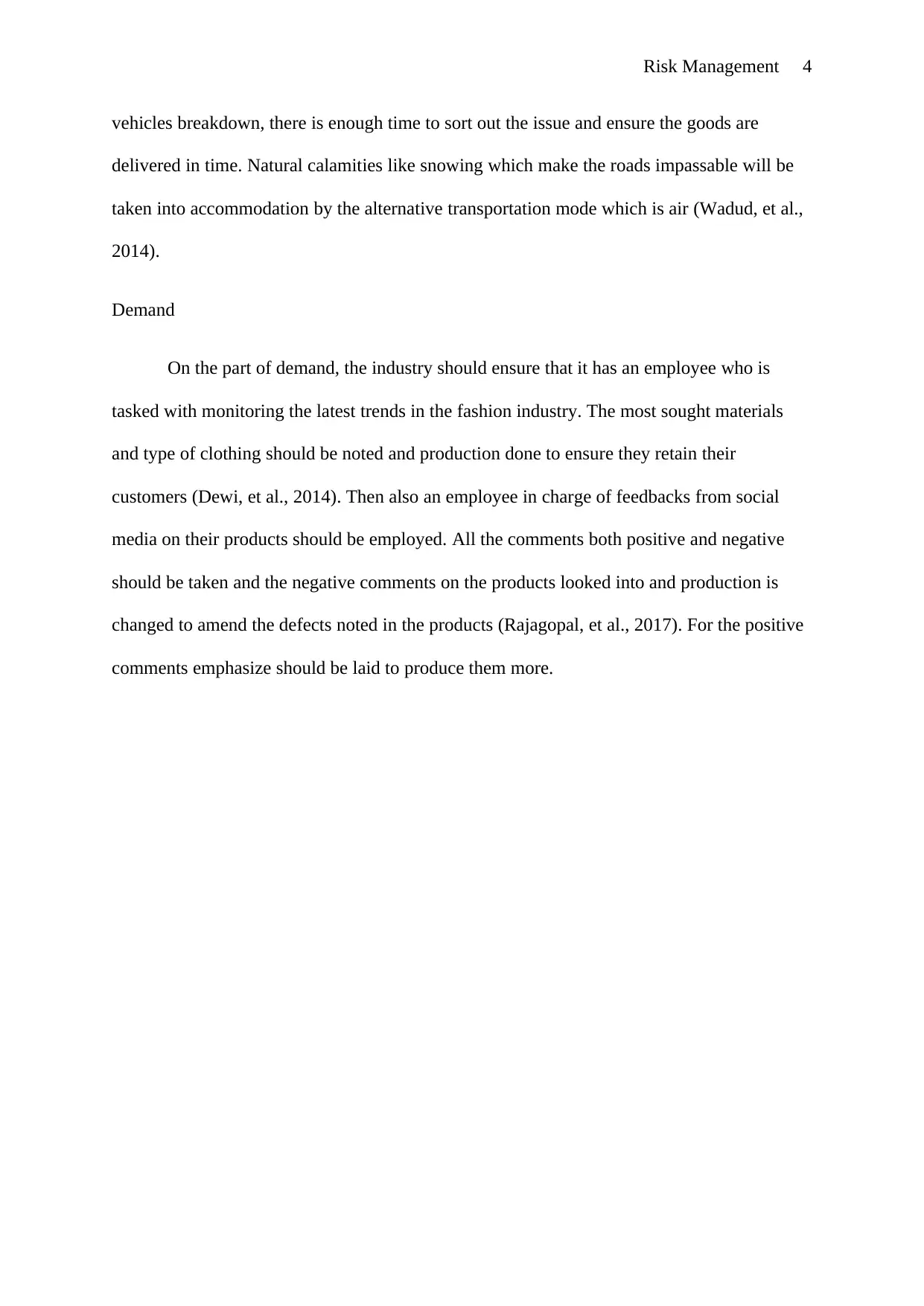
Risk Management 4
vehicles breakdown, there is enough time to sort out the issue and ensure the goods are
delivered in time. Natural calamities like snowing which make the roads impassable will be
taken into accommodation by the alternative transportation mode which is air (Wadud, et al.,
2014).
Demand
On the part of demand, the industry should ensure that it has an employee who is
tasked with monitoring the latest trends in the fashion industry. The most sought materials
and type of clothing should be noted and production done to ensure they retain their
customers (Dewi, et al., 2014). Then also an employee in charge of feedbacks from social
media on their products should be employed. All the comments both positive and negative
should be taken and the negative comments on the products looked into and production is
changed to amend the defects noted in the products (Rajagopal, et al., 2017). For the positive
comments emphasize should be laid to produce them more.
vehicles breakdown, there is enough time to sort out the issue and ensure the goods are
delivered in time. Natural calamities like snowing which make the roads impassable will be
taken into accommodation by the alternative transportation mode which is air (Wadud, et al.,
2014).
Demand
On the part of demand, the industry should ensure that it has an employee who is
tasked with monitoring the latest trends in the fashion industry. The most sought materials
and type of clothing should be noted and production done to ensure they retain their
customers (Dewi, et al., 2014). Then also an employee in charge of feedbacks from social
media on their products should be employed. All the comments both positive and negative
should be taken and the negative comments on the products looked into and production is
changed to amend the defects noted in the products (Rajagopal, et al., 2017). For the positive
comments emphasize should be laid to produce them more.
Paraphrase This Document
Need a fresh take? Get an instant paraphrase of this document with our AI Paraphraser
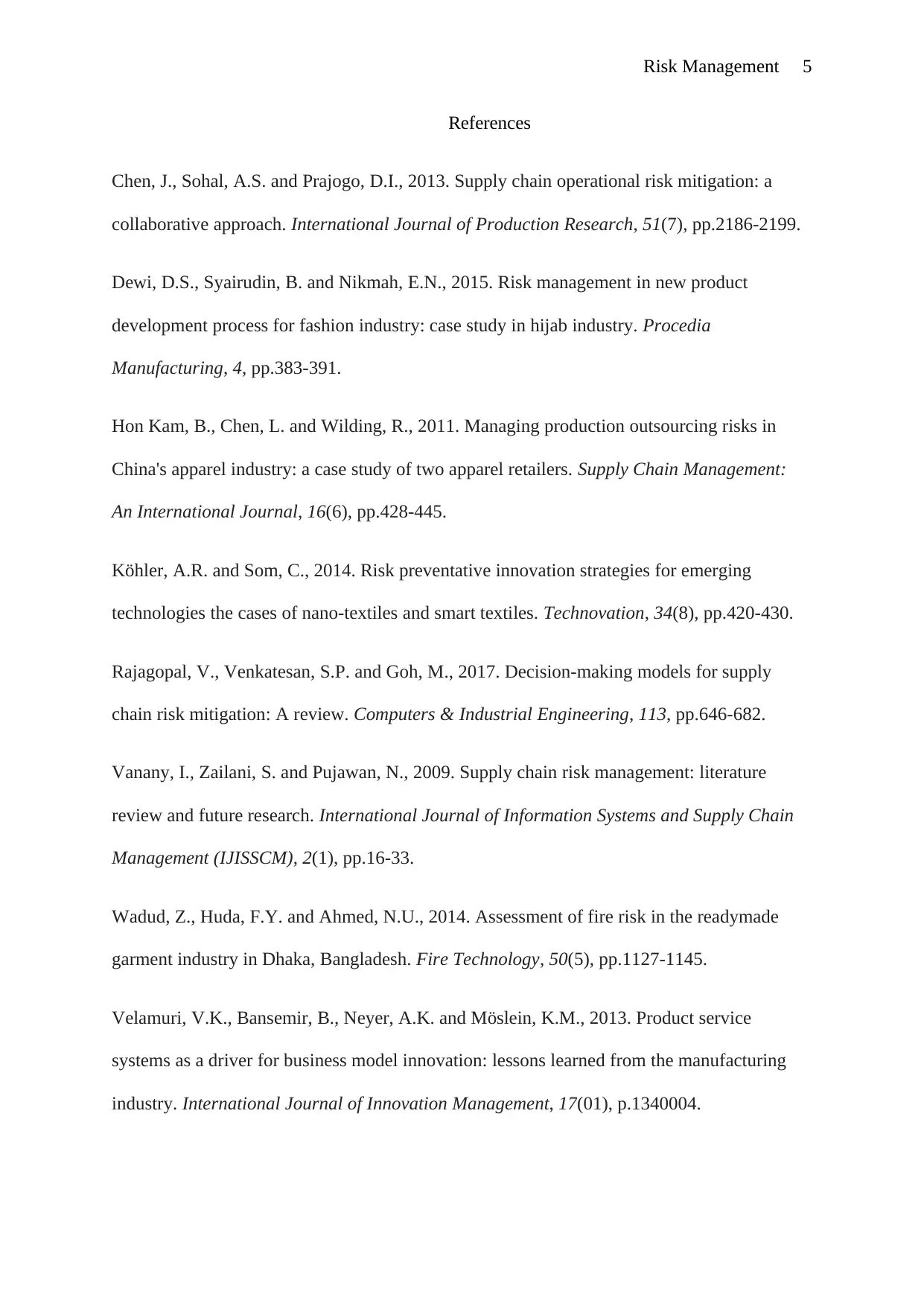
Risk Management 5
References
Chen, J., Sohal, A.S. and Prajogo, D.I., 2013. Supply chain operational risk mitigation: a
collaborative approach. International Journal of Production Research, 51(7), pp.2186-2199.
Dewi, D.S., Syairudin, B. and Nikmah, E.N., 2015. Risk management in new product
development process for fashion industry: case study in hijab industry. Procedia
Manufacturing, 4, pp.383-391.
Hon Kam, B., Chen, L. and Wilding, R., 2011. Managing production outsourcing risks in
China's apparel industry: a case study of two apparel retailers. Supply Chain Management:
An International Journal, 16(6), pp.428-445.
Köhler, A.R. and Som, C., 2014. Risk preventative innovation strategies for emerging
technologies the cases of nano-textiles and smart textiles. Technovation, 34(8), pp.420-430.
Rajagopal, V., Venkatesan, S.P. and Goh, M., 2017. Decision-making models for supply
chain risk mitigation: A review. Computers & Industrial Engineering, 113, pp.646-682.
Vanany, I., Zailani, S. and Pujawan, N., 2009. Supply chain risk management: literature
review and future research. International Journal of Information Systems and Supply Chain
Management (IJISSCM), 2(1), pp.16-33.
Wadud, Z., Huda, F.Y. and Ahmed, N.U., 2014. Assessment of fire risk in the readymade
garment industry in Dhaka, Bangladesh. Fire Technology, 50(5), pp.1127-1145.
Velamuri, V.K., Bansemir, B., Neyer, A.K. and Möslein, K.M., 2013. Product service
systems as a driver for business model innovation: lessons learned from the manufacturing
industry. International Journal of Innovation Management, 17(01), p.1340004.
References
Chen, J., Sohal, A.S. and Prajogo, D.I., 2013. Supply chain operational risk mitigation: a
collaborative approach. International Journal of Production Research, 51(7), pp.2186-2199.
Dewi, D.S., Syairudin, B. and Nikmah, E.N., 2015. Risk management in new product
development process for fashion industry: case study in hijab industry. Procedia
Manufacturing, 4, pp.383-391.
Hon Kam, B., Chen, L. and Wilding, R., 2011. Managing production outsourcing risks in
China's apparel industry: a case study of two apparel retailers. Supply Chain Management:
An International Journal, 16(6), pp.428-445.
Köhler, A.R. and Som, C., 2014. Risk preventative innovation strategies for emerging
technologies the cases of nano-textiles and smart textiles. Technovation, 34(8), pp.420-430.
Rajagopal, V., Venkatesan, S.P. and Goh, M., 2017. Decision-making models for supply
chain risk mitigation: A review. Computers & Industrial Engineering, 113, pp.646-682.
Vanany, I., Zailani, S. and Pujawan, N., 2009. Supply chain risk management: literature
review and future research. International Journal of Information Systems and Supply Chain
Management (IJISSCM), 2(1), pp.16-33.
Wadud, Z., Huda, F.Y. and Ahmed, N.U., 2014. Assessment of fire risk in the readymade
garment industry in Dhaka, Bangladesh. Fire Technology, 50(5), pp.1127-1145.
Velamuri, V.K., Bansemir, B., Neyer, A.K. and Möslein, K.M., 2013. Product service
systems as a driver for business model innovation: lessons learned from the manufacturing
industry. International Journal of Innovation Management, 17(01), p.1340004.
1 out of 5
Related Documents
Your All-in-One AI-Powered Toolkit for Academic Success.
+13062052269
info@desklib.com
Available 24*7 on WhatsApp / Email
![[object Object]](/_next/static/media/star-bottom.7253800d.svg)
Unlock your academic potential
Copyright © 2020–2025 A2Z Services. All Rights Reserved. Developed and managed by ZUCOL.





